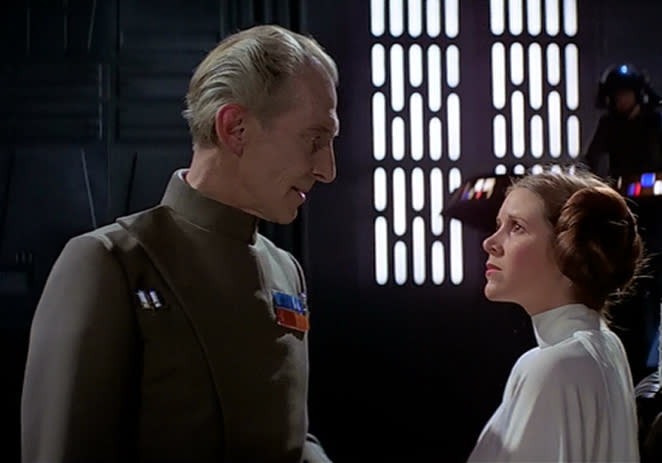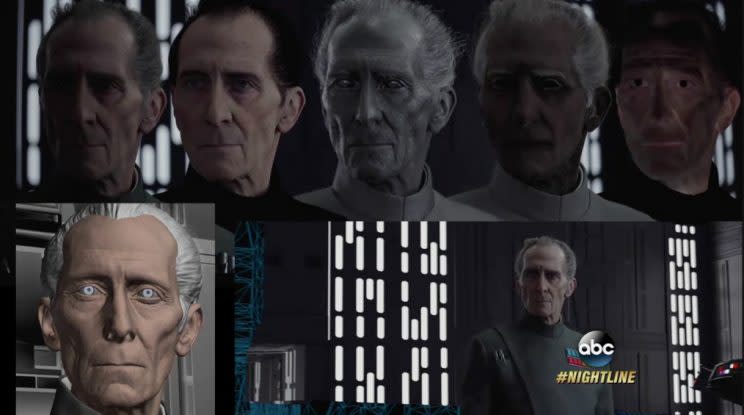'Rogue One' Creator Defends CGI Tarkin; Says Carrie Fisher 'Loved' Her Digital Self (But She Won't Come Back)

(Editor’s note: This story has been updated with a statement from Lucasfilm saying that filmmakers have “no plans” to digitally recreate Princess Leia for any future Star Wars films.)
Rogue One has drawn near-universal raves. It has been called the best Star Wars movies since The Empire Strikes Back on more than a few occasions. But there has been one glaring criticism of the standalone film: the digital reincarnation of Grand Moff Tarkin, the Death Star commander so memorably portrayed by the late Peter Cushing in 1977’s Star Wars: A New Hope. Time decribed it as “distracting.” Vulture called it “grave-robbing.” Countless folks in the Twitterverse complained that it was “creepy.” And Yahoo Movies’ Gwynne Watkins labeled it “terrifying for all the wrong reasons.”
John Knoll, the chief creative officer of Industrial Light & Magic and veteran effects guru who came up with the idea for Rogue One, has heard the criticism. And he respectfully disagrees. “It’s interesting, there are sort of different categories of response,” Knoll told Yahoo Movies. “There are people that have said quite vehemently that it looks terrible and looks like a video game, and I will assert that that is not the case.”
Related: The Secret Origin of Jyn Erso’s Name Revealed by ‘Rogue One’ Mastermind
There is also the notion that Tarkin’s recreation raises ethical questions, given that Cushing died in 1994 and therefore did not provide consent to appear in the film. Similar complaints have been logged against hologram musical performances from dead recording artists — interesting because Knoll has said they considered reviving the character as a hologram if they couldn’t sufficiently execute the trick via a motion-capture performance and visual effects, ultimately the methodology they employed.

“They fear a slippery slope,” Knoll said of the technology’s ethical critics. “‘Well if they’re going to do this now, where’s the end of it? Soon we’re going to have all sorts of dead celebrities endorsing products.’
Related: How Darth Vader Got His Groove Back, Thanks to Last-Minute ‘Rogue One’ Tweak
“I’ll say, well, first of all that’s not what we did. What we had Tarkin doing in this film I think was entirely appropriate narratively for this story, and we weren’t doing anything that I think Peter Cushing would’ve objected to. I think this work was done with a great deal of affection and care. We know that Peter Cushing was very proud of his involvement in Star Wars and has said as much, and that he regretted that he never got a chance to be in another Star Wars film because George [Lucas] had killed off his character.
“And this was done in consultation and cooperation with his estate. So we wouldn’t do this if the estate had objected or didn’t feel comfortable with this idea.” (Cushing’s former assistant, Joyce Broughton, who now oversees his estate, applauded ILM’s efforts. “It’s not just a silly sort of thing,” she told Variety. “It’s really good.”)

To achieve the effect, Knoll and team cast actor Guy Henry (Harry Potter and the Deathly Hallows) to perform the role on set while where wearing motion-capture equipment, including a helmet-mounted camera that would track facial expressions and vocal movements. They then used visual effects to apply the motion to a digital model they’d constructed of Tarkin/Cushing using photographs and footage of him from A New Hope. “Essentially we’re using the computer graphics as a tool to alter his appearance,” Knoll explained.
Related: See How ‘Rogue One’ Brought Grand Moff Tarkin and Princess Leia to Life
A similar approach was used in digitally producing a young Princess Leia in the final moments of Rogue One, set just minutes before the start of A New Hope. In the original trilogy as well as 2015’s The Force Awakens, Leia, of course, was played by Carrie Fisher, who tragically passed away Dec. 27 at the age of 60 after suffering a heart attack on an airplane.

Filmmakers combined the use of an on-set stand-in, digital effects, and 40-year-old audio of Fisher to complete the effect.
“This again is something we wouldn’t have done without her permission and blessing,” Knoll said. “She knew about it. [Lucafilm President] Kathy Kennedy managed the relationship with Carrie, so I didn’t talk with her directly about it. But [Fisher] saw a work in progress, saw a finished result, and she loved it. Kathy called me right after she showed it to [Fisher] and said how fantastic she thought it was. So she was very much in favor of it.”
In related news Friday, Lucasfilm denied a BBC report suggesting the company had already begun negotiating with Fisher’s estate for rights to her digital image for future Star Wars installments. Fisher had completed filming 2017’s Episode VIII and was expected to have a substantial role in 2019’s Episode IX, but Disney and Lucasfilm were scheduled to huddle with filmmakers this week to discuss how to adjust the story following Fisher’s death.
Here’s the complete statement, as posted on StarWars.com:
We don’t normally respond to fan or press speculation, but there is a rumor circulating that we would like to address. We want to assure our fans that Lucasfilm has no plans to digitally recreate Carrie Fisher’s performance as Princess or General Leia Organa.
Carrie Fisher was, is, and always will be a part of the Lucasfilm family. She was our princess, our general, and more importantly, our friend. We are still hurting from her loss. We cherish her memory and legacy as Princess Leia, and will always strive to honor everything she gave to Star Wars.
Take a look back at Carrie Fisher’s most memorable roles:

